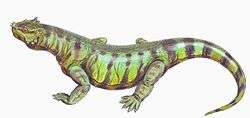Rhipaeosaurus
| Abyssomedon | |
|---|---|
 | |
| Rhipaeosaurus tricuspidens | |
| Scientific classification | |
| Kingdom: | Animalia |
| Phylum: | Chordata |
| Class: | Reptilia |
| Clade: | †Parareptilia |
| Order: | †Procolophonomorpha |
| Family: | †Nycteroleteridae |
| Genus: | †Rhipaeosaurus Efremov, 1940 |
| Type species | |
| †Rhipaeosaurus tricuspidens Efremov, 1940 | |
Rhipaeosaurus is an extinct genus of nycteroleterid parareptile known from the mid Middle Permian of European Russia from an articulated skeleton.[1] Bayesian inference suggests that it is more closely related to pareiasaurs than to the other nycteroleterids, due to skull and tooth features (see below). For this reason, 'Nycteroleteridae' is in fact a grade taxon rather than a clade.[2]
Features
Rhipaeosaurus is around a metre long, intermediate in size between nycteroleterids and later pareiasaurs. It had a short, stocky body and a broad flat skull. The skull had two small horns above each eye, four larger horns at the back of the head, cheek spines and a shelf of bone above the nostrils. Overall the skull looked rather like that of a Scutosaurus, but considerably smaller, very different to the longer and less ornamented skulls of other nycteroleterids. Its teeth were large and, as the name suggests, three-cusped. This is generally considered intermediate in form between the one- or two-cusped teeth of earlier nycteroleterids and the multi-cusped teeth of pareiasaurs, indicating it could probably have eaten insects, smaller animals, and vegetation.[2]
The neck was a little longer than the head. Rhipaeosaurus' legs were splayed out to the sides, typically for a parareptile. Its tail was shorter for its size than that of Nycteroleter, but longer than those of either Emeroleter or the pareiasaurs. Why this was so is not known. It is probable that Rhipaeosaurus possessed efficient impedance-matching hearing as did the rest of the Nycteroleteridae.[2]
Name and taxonomy
Rhipaeosaurus was first discovered in 1940, in the Ural Mountains of Russia. The name 'Rhipaeosaurus' comes from 'Ῥιπαεος' 'Rhipaeos', a range of mountains in Greek mythology thought to be the Urals, and 'σαυρος', meaning 'lizard'. 'Tricuspidens' refers to its three-cusped teeth (see above).
Rhipaeosaurus' taxonomic history has been full of difficulties. At first it was placed in its own family, the Rhipaeosauridae, and considered the type specimen. Other species, such as Parabradysaurus and Leptoropha joined it in this family. When more remains of these species were found, however, all the rhipaeosaurids but the original turned out, in fact, not to be rhipaeosaurids at all. Parabradysaurus was in fact an estemnosuchid, more closely related to mammals, and Leptoropha was identified as a seymouriamorph amphibian. Rhipaeosaurus' affiliations with the Nycteroleteridae and Pareiasauridae were then noticed and it was moved into the position it still holds today, an intermediate species in a grade of fossils. This is possible because the fossils are spread over time, whereas with modern animals this is not possible to do.[2]
References
- ↑ Tsuji, Linda A.; Müller, Johannes; Reisz, Robert R. (1 January 2012). "Anatomy of Emeroleter levis and the phylogeny of the nycteroleter parareptiles". Journal of Vertebrate Paleontology. 32 (1): 45–67. doi:10.1080/02724634.2012.626004. Retrieved 10 September 2012.
- 1 2 3 4 "Palaeos Vertebrates Anapsida: Nycteroleteridae". palaeos.com. Retrieved 2018-03-11.